

Introduction
Terraforming using asteroids
What are asteroids?
What do asteroids consist of?
Where are the asteroids and how many are there?
Different approaches
Direct Impact
Propulsion System
Nuclear Explosives
The asteroid belt and the terrafactory
The ice asteroid in "Red Mars"
Conclusion
At the moment of the collision between the asteroid and the surface of Mars the heat will melt the ice carried with the asteroid. Water flows through the dry sand, gases can freely expand and the ground warms up for first time after an undisturbed period of thousands or rather millions of years. Such a scenario sounds wonderful, dramatic and perfect in the eye of any futurologist. But the realization of such a plan is not likely to take place in the next five hundred years. The problems and mistakes that can ruin such a mission are great, even greater than the chance of success. The maneuver of moving a structure with a diameter of several kilometers has never been tried before. Different technologies and systems have to be synchronized and if one of them fails, the whole project breaks down. Here are the steps that have to be completed to achieve a successful mission: 1. Find a good asteroid which is usable for terraforming 2. Find different propulsion systems useable on the asteroid 3. Find a path for the asteroid, using other planets as a slingshot in the process 4. Initiate an alternate ballistic course of the asteroid 5. Pick the perfect impact velocity: if it is too fast there will be considerable collateral damage, if it is too slow the effect will be insufficient 6. Bring the asteroid close to the perfect speed 7. Eventually break the asteroid using atomic bombs to prevent a complete surface destruction After these points are accomplished another great danger occurs: What if all the calculations are right by the book, but the reality looks completely different: The impact might ruin Mars's atmosphere forever ejecting part of it into space and leaving a toxic gas-layer above the planet's surface. Unknown gases might have been hidden inside the asteroid that are set free for the first time at the moment of impact. But the idea still remains fascinating. If things work out according to the plan, mankind could save thousands of years shaping the planet by just doing all the required changes in a few seconds.
Before understanding the concept of terraforming using asteroids we have to understand what asteroids are, what they do, what they consist of and what kind of different asteroids are "out there".
Asteroids are large chunks of material floating in space at different velocities, until they hit another object. This other object could be another asteroid, a planet or anything floating in space. In the worst case the floating object would be a spacecraft. Bodies the size of several millimeters can shatter the hull of the spacecraft and endanger the life of the astronauts. That is the reason why even small loose particles like screws threaten space missions.
Usually asteroids are a danger to any living beings on a planet because of their very strong impact. An asteroid the size of a football-field and 50 meters in height (100x60x50) would have the energy of 39000 Terra Joule, which equals about 14 million tons of coal.
This can be calculated by means of the equation:
W = ½ * m * v2
W = Energy
m = mass
v = velocity
Taking the volume of the body and multiplying it by the density can determine the mass. The normal density of an asteroid (rock) is about 2600 kg/m3. That means that a cube of 1 meter weights about 2600 kg. If a body has the volume of 300000 m3 the mass would be 780000000 kg or 780000 tons.
m = V * prock = 300000 m3 * 2600 kg/m3 = 780000000 kg = 780000 t
V = volume
prock = density
Another required factor is the velocity of the flying object which ranges from 300 meters per second to more than 30000 meters per second. The average asteroid flying in the asteroid belt has an impact velocity of 10 km/s or 10000 meters per second. If we insert those figures in the equation we get the energy of the impact:
W = ½ * m * v2 = ½ * 780000000 kg * (10000 m/s)2
W = 3.9 * 1016 J = 39000TJ
V = volume
prock = density
J = Joule
TJ = Terra Joule = 1012 Joule
If we want to get the amount of coal needed to produce this energy we have to know how much energy one ton of coal contains: one ton of coal generates 0.79 kWh . One Joule equals 2.778 * 10-7 kWh, thus 39000 TJ are 1.08 * 1010 kWh. A power station like the one in Weisweiler in Northrhine Westfalia would burn 13,714,177 tons of coal to generate the amount of energy set free by the impact of such a rather small asteroid.
1000 kg coal <=> 790 kWh
1266 kg coal <=> 1000 kWh
1 J = 2.778 * 10-7 kWh
39000 TJ = 1.08342 * 1010 kWh
1.08 * 1010 kWh <=> 1.371 * 1010 kg coal = 13714177 t coal
This computation shows the amounts of energy set free by asteroids at the moment of impact. This energy is important for the terraforming process, because part of the energy will heat up the atmosphere, which is a desirable side effect.
There are three categories asteroids can be placed in. The first ones are made of stony meteorites known as carbonaceous chondrites. These are considered the oldest material in the solar system. Being dark in color, they have never melted or cooled down since their creation. The asteroids of this material are called asteroids of the C-Type. Asteroids of the S-Type are made of iron and are related to the M-Type, which is an iron-nickel mix. Most scientists are not certain as to whether asteroids are parts of former planets. Most believe that there were some primeval asteroids in the solar system that collided with each other and formed smaller ones. The impact on the surface will heat up the atmosphere, but it will not procreate the essential gases so badly needed for a living environment. The most expedient asteroids are the ones containing a lot of water (ice), some CH4, CO2 and NH3. The CO2 is needed for the greenhouse effect, which heats up the atmosphere. Contrary to the earth, Mars has not enough CO2, so the rays of the sun just bounce off the surface and leave the planet, whereas CO2 would keep them within the atmosphere.
Most asteroids are to be found in asteroid clouds. An example of those clouds are the Trojan asteroids. They follow the path of Jupiter, the first part of the cloud following Jupiter's path at 60°, the other one being 60° ahead. This arrangement has been originated by Jupiter's great mass. Any object coming close to this giant planet would be drawn into Jupiter's gravitational field and forced to hit the surface. Without Jupiter life on earth probably couldn't exist because many asteroids would have hit the earth if Jupiter's gravitational field had not pulled away them from their life-threatening course towards Earth. There are not that many asteroids in our solar system. If we added up the mass of all of them we would get much less than the moon's mass, so there is not that much of a choice when picking an asteroid for terraforming.
There are several possibilities of terraforming Mars with extra-planetary means. Asteroids aren't the only possibility, even though they are the most promising ones. Comets could be used and even small ice moons (like Hyperion, being a satellite of Saturn) are a good source of water and nitrogen. Comets and asteroids differ in density. An average comet has a density of 1000 kg per m3, whereas asteroids usually have 2600 kg per m3. This makes a very big difference at the moment of impact: Asteroids release more energy and vaporize the ground more than comets. Asteroids and comets also vary in their amount of volatile. Volatile is the amount of vaporized material clouding the object. Comets consist of 50% volatiles, asteroids of only 5% (comets mostly have a tail of these volatiles following them).

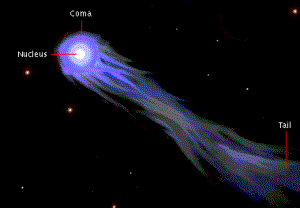
Left image: The asteroid 243 Ida in August 1993. Source : Microsoft Encarta 1997 Right image: The structure of a comet (no photography) showing the tail, the coma and the nucleus. Source: Microsoft Encarta 1997
Usually comets look much bigger than they are. Halley's Comet for example exceeds the size of Jupiter (including the hazy coma), but the solid part, the nucleus, is only 15 by 4 km in size. Usually comets contain lots of ice, so they are ideal for terraforming purposes. The problem lies in their distance from the target planet: Comets can most often be found in the outer solar system and are therefore much harder to move to Mars than most asteroids. Because of their long dust-tails comets are harder to approach and manoeuvre than asteroids.
When using an asteroid the problem of moving it to the target planet (in this case Mars) requires a lot of energy. To reduce the necessary energy one could divide the object into smaller parts and start moving these. This would not only reduce the amount of energy but also reduce the risk of a catastrophic impact because of the big size. Asteroids with a diameter of several kilometers would prove manageable when "cut" into smaller pieces.
When elaborating the plan dividing asteroids into smaller pieces Freeman Dyson brought up the idea of a self-reproducing robotic factory. The material required for the follow-up factory would be taken from the asteroid itself. Only one of those factories would have to be built, which would then multiply, a process that might take about a month. After a year there would be a total of 212 machines, i.e. 4096. At the end of this process the machines start taking the moon apart. This would not take too long, considering a work force of 4096 machines. Just adding another month would have doubled the number. Freeman Dyson suggested taking one of Saturn's satellites, Enceladus, being 500 km in diameter. Equipped with a solar sail each piece would then change direction towards Mars.
The greatest problem is to move the objects. In the above scenario, this problem has been solved by reducing the size of the objects. If such a machine as described above should ever be built, its construction will be a feat of a more distanced future. The only way to move a body from its orbit is to change its velocity. This change of velocity is called ?v, where ? means change. This ?v would be made perpendicular to the movement of the object, so the path would be changed. Three methods have been found to provide this deflecting impulse:
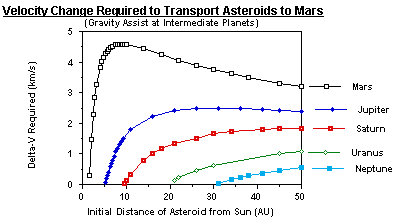
![]()
For smaller objects (with a radius of less than 100 m) a simple collision with an object, for example a rocket, would change the path radically. A rocket weighing 2000 tons, traveling at 500 m/s and hitting the object laterally would change the asteroid's velocity by 0.163 m/s.

Mrocket = 2000 t = 2000000 kg = 2 * 106 kg assuming a spherical object: V = ¾ * PI * (100m)3 = 2356194m3 m = V * 2600 kg / m3 = 6.126 * 109 kg ½ * masteroid * (vasteroid)2 = ½ * mrocket * (vrocket)2 (vasteroid)2 = mrocket * (vrocket)2 / masteroid = 2 * 106 kg * (500 m/s)2 / 6.126 * 109kg vasteroid = 9.03 m/s
This is not very much considering the length of time required reach Mars (one year of flying time would change the course by 4183 km.
1 year = (60 * 60 * 24 * 356) s = 30758400 ( seconds per year ) 9.03 m/s * 30758400 s = 277748 km
This may be enough to change the planet's course, but will not be sufficient for the discussed purposes. The method seems to be feasible for smaller objects but it would require thousands of them to achieve a palpable change on Mars. When greater bodies have to be moved we need better and more efficient systems that can move greater objects.
Propulsion systems are used to move larger bodies (that exceed a radius of 100 m) around the solar system. One method is the attachment of large engines to one side of the asteroid, which will mine material from it and eject it into space. This matter will accelerate the asteroid in the opposite direction (the way a rocket works, just slightly larger). The higher the velocity the more thrust will be applied to the asteroid. Assuming that one of those machines could accelerate the mined material to the speed of vpush, and mining n kg of material per second we can calculate the time needed to achieve a ?v of vasteroid. t shall be the time the engines will run.
½ * masteroid * (?vasteroid)2 = ½ * mpush * (vpush)2 [n] = kg/s Total material minde: mpush = n * t ½ * masteroid * (?vasteroid)2 = ½ * n * t * (vpush)2 V = ¾ * PI * (rasteroid)3 masteroid = V * 2600 kg / m3
t = masteroid * (?vasteroid)2 / (n * (vpush)2 )
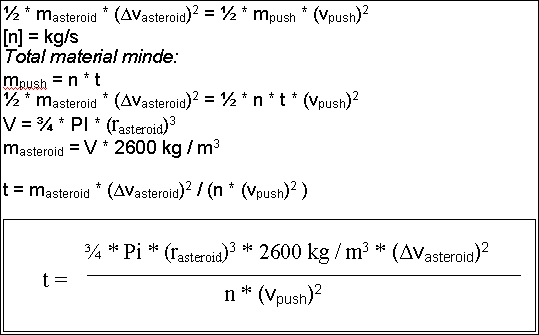
rasteroid is the radius of the asteroid (spherical) (e.g. 1000m) ?vasteroid is the change of the asteroids velocity (e.g. 5 m/s) n is the material mined per second (e.g. 100 kg/s) vpush is the speed of the accelerated and mined material (e.g. 500 m/s)
On the basis of those sample values the time needed to move the asteroid 5 m/s would be about 6000000 s or 70 days. The radius of this object is only 1000m, but the time needed cubes with the increase of the radius (e.g. if radius is 5 times as big the time will be eauivalent to 53 = 125). Taking a more realistic value for the radius (about 40 km) the time growths to 12746 years. This number shows how unrealistic the value for n is. Increasing the amount of material mined per second would be achieved by putting 100 of those machines on the asteroid. They would be able to mine 10000 kg of material per second. The time would decrease to 127 years, which seems to be more realistic. The question is how many of those machines are realistic. We have to bear in mind that each of them needs a great amount of energy to accelerate the material up to 500 m/s, so we can't just place as many engines on them as we want. The best and actually only method of winning the fuel would be by taking it from the asteroid itself. The material could also be ejected by using electrical energy. The mined material would then be electrically charged and accelerated by an electrical field. This method would not require any burning process but could operate on electrical power which could easily be generated by solar panels instead of extracting the power from the asteroid.
The basic problem of the propulsion system is the time. We cannot expect to use asteroids for the terraforming process within the next 100 years or so. But I think it is commonly known that we cannot change the face of a planet within 20 years.
The last alternative and most practical one is the detonation of a nuclear missile. To use the largest amount of energy set free by the explosion the first possibility is the detonation right on the surface of the object. The explosion would then eject large amounts of matter away from the object, which gives it a thrust in the opposite direction. At the same time the pressure of the explosion pushes the asteroid to the opposite direction, creating an even greater ?v. The problem of this method is the risk of damaging the asteroid too heavily. If the ?v needed is too big, the explosives have to be more powerful, too. The impulse of the explosion could rip the small asteroid apart and the two pieces would leave the pre-calculated course. This would not be a disaster taking into account that there are other asteroids around, but the loss would cost dearly. Another way of using nuclear explosives is the stand-off detonation. This idea bases on the neutrons absorbed by the explosion. The crust of the asteroid will absorb the neutrons and therefore heat up. Because of the increase in heat the crust will than expand and in the end depart from the asteroid, which will create a ?v into the opposite direction. The thickness of the affected crust is only 20 cm, but the size of the area will be able to achieve a change. The problem is that once the radius of the asteroid expands the ?v is so small that thousands of nuclear explosions would be required to accomplish a change.
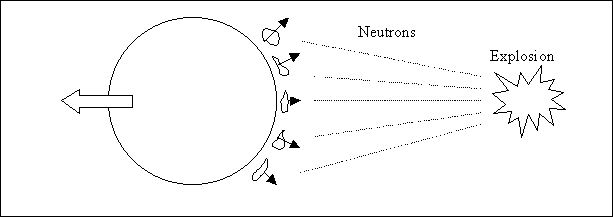
Nuclear explosives are not practical for moving asteroids as part of a terraforming scenario. The objects needed are so big that the impact of a nuclear explosion would be insufficient.
I personally think the best of these three methods is the second one. Right now it does not seem feasible to build thrusters on a relatively large body in space enabling it to move it around, but the criterion of feasibility applies to all of the above ideas. The second one though is the only one suited to move large bodies as the ones needed for terraforming.
Another idea of terraforming Mars using asteroids was proposed by Lloyd E Vancil. He suggested building a terrafactory. This is basically a spaceship located at the inside of the outer asteroid belt which builds three types of different robots. The first one will seek out and search radioactive matter to be used as fuel. After finding such resources the robot would be positioned on the asteroid and start mining it. The second robot would search the asteroid belt for asteroids containing ice water, radioing their positions to the third kind of robots. The third robot, being a smart engine, would land on the asteroid and start burrowing into to the ice. The nuclear power plant on board the smart space-robot would then accelerate the ice creating a jet of steam. This would gradually accelerate the icetroid (i.e. an asteroid consisting of ice) propelling it towards its new home: Mars. The nuclear power plant would be fuelled by the radioactive material mined by the first type of robots. The terrafactory would make its way into the asteroid belt and start building the different kind of robots. Mars would be bombarded by thousands of small ice-asteroids all impacting the object and setting free large amounts of energy. The hope of Lloyd E Vancil is that the bombardment will also activate the volcanic activity of Mars thus increasing the temperature of the atmosphere. He thinks the first results could already been seen 100 years after the first impact on Mars.
The novel "Red Mars" by Kin Stanley Robinson is about the colonization of Mars, including terraforming. The main proponent of terraforming, Sax, has the idea of using an ice asteroid for the process of terraforming. Mars was already settled at this point of time, so the impact of the of an ice asteroid would have killed thousands of people and destroyed the surface of Mars. Anthropologist Ann is an important opponent of the terraforming process wanting to keep Mars as it is to find out if any life has ever existed on it. The impact of an asteroid would have destroyed important parts of the surface thus destroying any traces of life on Mars. More importantly, a direct impact is not feasible, because it could kill people and destroy human colonies on Mars. Therefore Sax decides to have an indirect impact. This means the asteroid enters the planet's atmosphere at a very low angle avoiding a direct hit and burning up in the atmosphere.
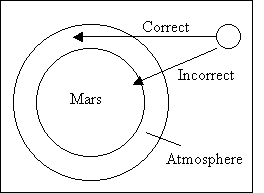
That leaves all the hydrogen, the oxygen and the water in the atmosphere, but nothing really hits the planet itself thus avoiding destruction of the surface and collateral damage.
Terraforming Mars will definitely be a project for the future, not because we are not capable and do not have the technology of changing it right now, but because it isn't necessary right now. Terraforming will become a priority after the first Martian colonies have been built and the first humans start to live there over periods of more than 20 years. Why should we plan the process of terraforming in detail when we are not even able to land on Mars? Terraforming will involve close study of the planet, so the effects can be foreseen in detail and the process should not end in uncertainty. The basic ideas should be studied and examined, but facts and realistic results can only be made after close examinations of the planet. Therefore our first goal should be Mars itself. We have to focus on landing on the planet and building the first colonies. The advantage of using asteroids is the relatively low budget required for such a project. We can change everything with just one big crash. The whole environment can be changed to our advantage creating a green and blue planet full of life. The only problem is the enormous energy created by the impact of the asteroid. Just a small mistake could damage the planet forever, leaving a dead and destroyed place. If the angle of the incoming object is too steep the surface will be changed beyond recognition. In the process more matter could be ejected from the planet than it gained, which would result in a great loss rather than in a win. I am sure that once planet Mars is colonized terraforming will come, no matter what.
Martin Brodeck, February 6th, 2000
Used literature:
Terraforming by Martyn J. Fogg; 1995
Rheinbraun; Forschung und Entwicklung; 1994 Köln
“Asteroid," Microsoft® Encarta® 97 Encyclopedia.